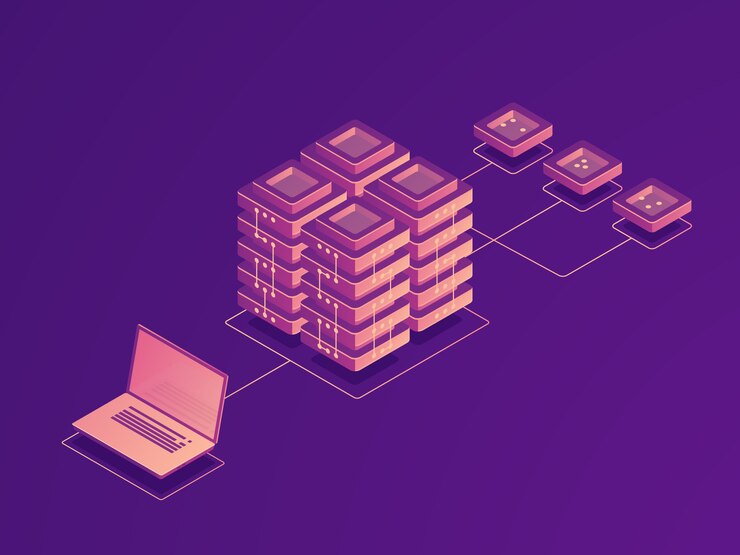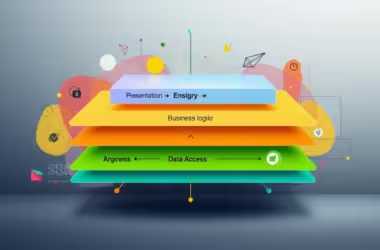Choosing between a Monolithic vs Microservices architecture can make all the difference. Both offer distinct advantages and challenges, shaping your application’s scalability, maintainability, and overall success.
In this guide, let’s delve into these architectural approaches to determine the differences between Monolithic Vs Microservices Architecture and the best instances to use both. Also, you can find which one fits your project.
What Is A Monolithic Architecture?
A monolithic architecture refers to a traditional approach where all components of an application are tightly integrated into a single codebase or executable. Thus, it’s like constructing a large, unified structure. So, every part of the software – from the user interface to the backend logic and database – is housed within the same application.
In simpler terms, think of monolithic architecture as building a massive skyscraper with all its floors, rooms, and facilities bundled together in one solid structure. Hence, this cohesive unit operates as a single entity, with no clear separation between different functionalities.
Advantages Of Using A Monolithic Architecture
- Simplicity: With everything neatly packed into one box, understanding how different parts of your application work together is challenging. Hence, it’s like having all your tools neatly organized in a single toolbox.
- Development Speed: Since you’re working with one cohesive unit, making changes or adding new features can be swift.
- Deployment Ease: Deploying a monolithic application means you pack up everything and move in one go.
- Debugging Bliss: When bugs crop up, tracing them in a monolith is accessible – everything leads back to one source, making debugging a straightforward affair.
Disadvantages Of Using A Monolithic Architecture
- Complexity Overload: Managing a monolith’s intricacies can feel messy as your application grows.
- Scalability Hurdles: Scaling up a monolithic application is a delicate balance that often results in inefficiencies.
- Technology Lock-in: Adopting new technologies or frameworks becomes messy and disruptive.
- Deployment Bottlenecks: Updating a monolithic application is a lot of effort for a small change.
What Is A Microservices Architecture?
In contrast to a monolithic architecture, a microservices architecture is a modern approach to software development . In microservices architecture, an application is broken down into more minor, independent services. Hence, each service focuses on a specific function or feature, operating autonomously and communicating with other services through well-defined interfaces.
Thus, the application comprises numerous self-contained services in a microservices architecture, each responsible for a particular task.
The decentralized structure provides greater flexibility, scalability, and resilience. Also, changes or updates are effective and made to individual services without affecting the entire application.
Advantages Of Using A Microservices Architecture
- Scalability: Scaling up a microservice is seamless and efficient.
- Flexibility: With each service being its entity, teams can choose the best tools for the job. It’s like having a toolbox with every tool imaginable.
- Resilience: If one service goes down, the rest of the application continues without a hitch.
- Agility: Updating a microservice is quick and easy and does not disrupt the entire house.
Disadvantages Of Using A Microservices Architecture
- Complexity: Managing a multitude of microservices is complex as each goes its way, making coordination a challenge.
- Overhead Overload: With great flexibility comes great responsibility – managing the communication between microservices can add layers of complexity.
- Deployment: Deploying microservices requires precise timing and coordination to ensure harmony.
- Testing: Testing a network of microservices is- just when you think you’ve got it under control, another issue pops up.
Differences Between Monolithic Vs Microservices Architecture

When comparing monolithic and microservices architectures, there are several vital differences emerge. These differences influence on the way the software is developed, deployed, and maintained as discussed below:
- Structure:
- Monolithic: A single, tightly integrated codebase housing all application components.
- Microservices: Comprised of multiple independent services, each responsible for specific functionalities.
- Scalability:
- Monolithic: Scales by deploying the entire application, leading to potential inefficiencies.
- Microservices: Enables individual service scaling, allowing specific components to handle increased loads independently.
- Development:
- Monolithic: Initial development may be faster, but changes can become complex as the application grows.
- Microservices: Offers greater development flexibility, with teams focusing on individual services, leading to specialized expertise and faster development cycles.
- Deployment:
- Monolithic: Deployed as a single unit, requiring redeployment of the entire application for any changes.
- Microservices: Each service are independently deployed, facilitating rapid iteration and reducing the risk associated with large-scale deployments.
- Fault Tolerance:
- Monolithic: Lack of isolation between components can lead to application failures if one component encounters issues.
- Microservices: Isolated services ensure that failures in one component do not affect the whole application, enhancing fault tolerance.
- Technology Stack:
- Monolithic: Typically utilizes a single technology stack throughout the application.
- Microservices: Allows for the use of diverse technologies, enabling teams to select the best tools for individual services.
- Complexity:
- Monolithic: Becomes increasingly complex as the application grows, potentially leading to longer development times and increased risk of errors.
- Microservices: While managing numerous services can be complex, the decoupled nature of microservices simplifies the development, maintenance, and scaling of individual components.
- Testing and Debugging:
- Monolithic: Easier end-to-end testing but may encounter challenges in isolating and debugging specific issues.
- Microservices: Requires comprehensive testing strategies for integration across services but facilitates easier isolation and debugging of individual components.
When To Use Monolith Architecture?
Here are some situations where opting for a monolithic architecture might be appropriate:
- Small to Medium-Sized Projects: Monolithic architecture is ideal for smaller projects with limited complexity.
- Limited Resources: When resources such as time, budget, or expertise are constrained, a monolithic architecture is a pragmatic choice.
- Tightly Coupled Components: When components of an application are closely interconnected and do not require independent scaling or deployment, a monolithic architecture may be sufficient.
- Predictable Workloads: Monolithic architectures are well-suited for applications with predictable workloads and steady traffic patterns.
- Prototyping and MVP Development: During the early stages of prototyping or developing a minimum viable product (MVP), development speed is often prioritized over scalability and flexibility.
When To Use Microservices Architecture?
Here are some situations where opting for a microservices architecture might be appropriate:
- Complex and Evolving Applications: Microservices architecture benefits large-scale, complex applications with evolving requirements.
- Scalability Requirements: When scalability is a primary concern, microservices architecture excels. Microservices helps for individual components of an application to scale independently based on demand.
- Diverse Technology Stacks: Microservices architecture will enable teams to choose different technologies, programming languages, and databases for each service based on its specific requirements.
- High Availability and Fault Tolerance: Microservices architecture enhances the resilience of applications by isolating failures from individual services. If one service experiences an issue or failure, it does not impact the entire application, resulting in improved fault tolerance and higher availability.
- Independent Development and Deployment: Microservices enable teams to work independently on different services, allowing for parallel development and deployment cycles.
- Heterogeneous Development Teams: In organizations with diverse teams working on different components of an application, microservices architecture provides a natural fit. Each team can focus on developing and maintaining a specific service, leveraging their expertise and autonomy while minimizing coordination overhead.
- Cloud-Native and Containerized Environments: Microservices architecture aligns well with cloud-native principles and containerized environments. It allows applications to take full advantage of cloud services, such as auto-scaling, dynamic resource allocation, and service discovery.
FAQs: Monolithic Vs Microservices Architecture
What Is The Difference Between Microservices And Monoliths?
Microservices architecture breaks down an application into more minor, independently deployable services that communicate through APIs. Each service is responsible for specific functionalities alongside, developed, deployed, and scaled independently. In contrast, monolithic architecture involves building the entire application as a single, tightly integrated unit, with all components sharing the same codebase, database, and runtime environment.
Why Move From Monolith To Microservices?
Organizations often transition from monolithic to microservices architecture to address scalability, flexibility, and agility requirements. Microservices offer advantages such as independent scaling, faster development cycles, improved fault tolerance, and better support for diverse technology stacks.
Is Docker Monolithic Or Microservices?
Docker is a containerization platform helping applications as packaged into lightweight, portable containers. These containers are microservices-based applications. Hence, Docker is used with a microservices architecture to simplify deploying, scaling, and managing individual services within a microservices-based application.
What Is The Difference Between Monolith And Microservices In Python?
The difference between monolithic and microservices architecture in Python is the way the applications are structured and deployed. In contrast, a Python application following a microservices architecture is divided into more minor, independent services. Also, each one is responsible for specific functionalities. Thus, these services communicate through APIs, and they developed, deployed, and scaled independently.
Final Thoughts
There’s no one-size-fits-all answer in the eternal debate of monolithic vs. microservices architecture. It all comes down to understanding your project’s needs, constraints, and goals.
Depending on your requirements for the simplicity of a monolith or the flexibility of microservices, remember that adaptability is critical. Be open to evolving your architecture as your application grows and your needs change.
After all, in the ever-changing landscape of software development, flexibility is the ultimate blueprint for success.






